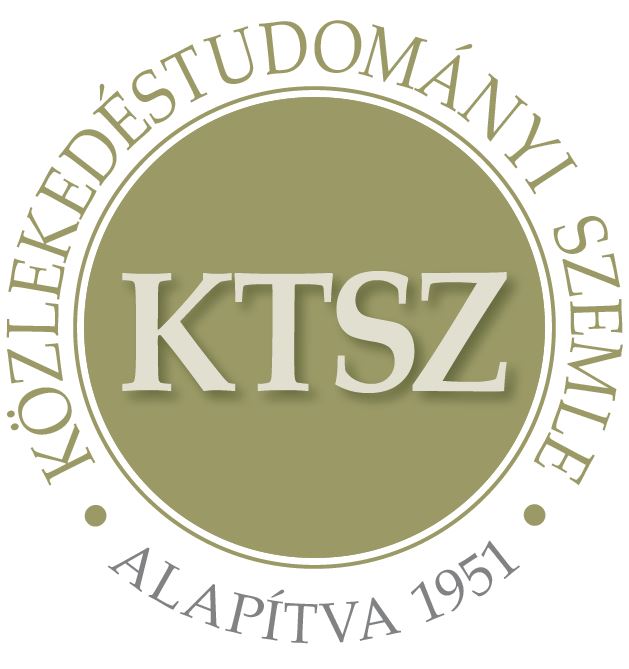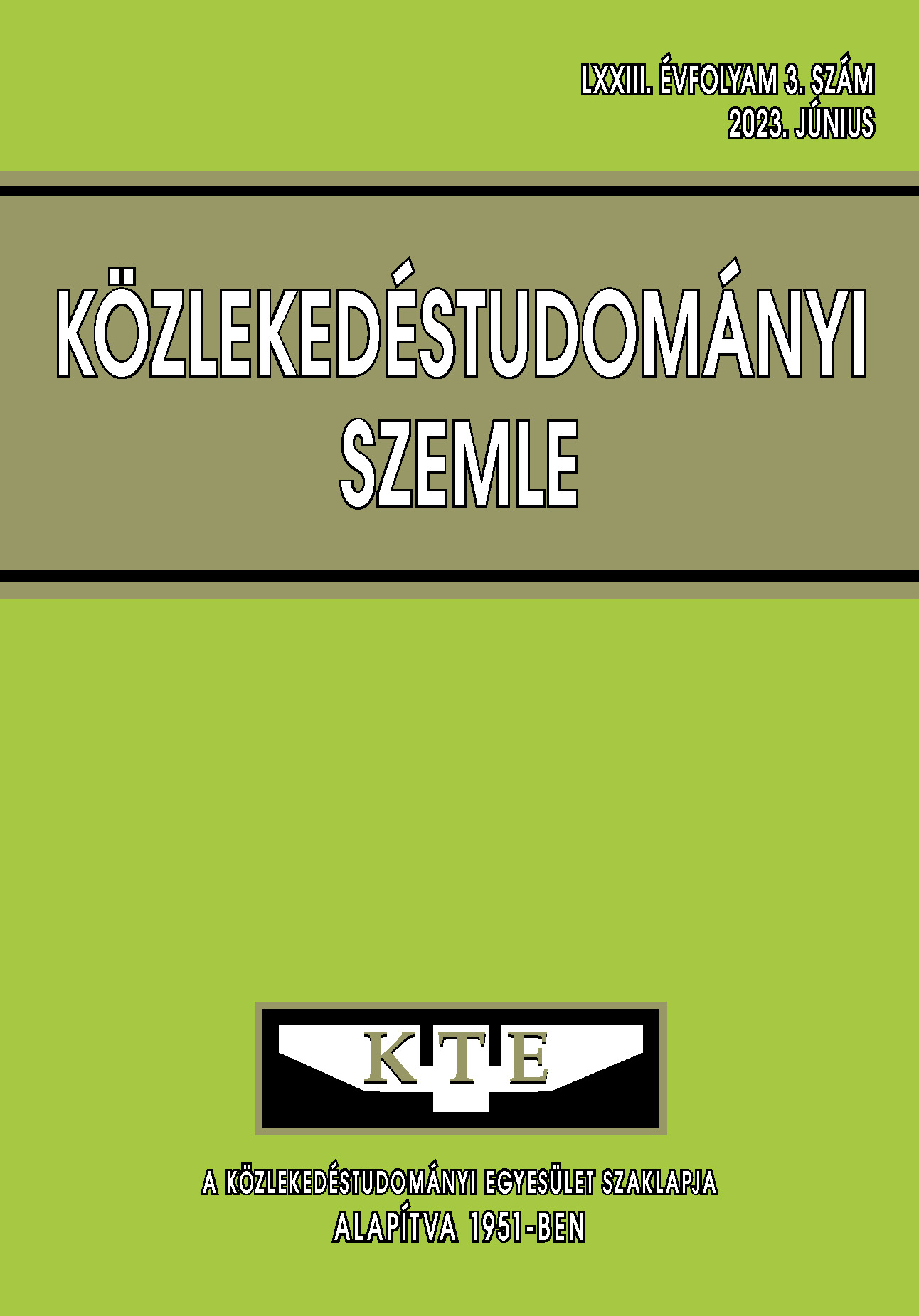The rise of electrification and the prominent role of electric buses in sustainable public transport
Abstract
The decarbonisation and efficient, energysaving operation of transport is the most important task for public transport providers in the coming years. Volánbusz Zrt. is preparing for electrification by continuously modernizing its vehicle fleet and transforming its operating model. In the first part of the article series, the authors present the trends and international
and domestic factors related to the integration of electric buses, based on extensive literature research. In the next part of the series of articles, the data-driven operating model based on the pilot projects of Volánbusz Zrt., which enables the achievement of the set goals, will be described.
References
Boré, S., Nurhadi, L., Ny, H.; Preferences of Electric Buses in Public Transport; Conclusions From Real Life Testing in Eight Swedish Municipalities, World Academy of Science Engineering and Technology International Journal of Enviromental, Chemical, Ecological, Geological and Geophysical Engineering; 2016.
Jefferies, D., Göhlich, D., A comprehensive tco evaluation method for electric bus systems based on discrete-event simulation including bus scheduling and charging infrastructure optimisation, 2020, Technische Universität Berlin, https://www.mdpi.com/2032-6653/11/3/56 DOI: https://doi.org/j9xt
Az Európai Bizottság tervei szerint 2050-re valamennyi busznak nulla károsanyagkibocsátásúnak kell lennie (EUR-Lex - 52020DC0789 - EN - EUR-Lex (europa.eu))
Boya Zhou Real-world performance of battery electric buses and their lifecycle benefits with respect to energy consumption and carbon dioxide emissions - ScienceDirect, Energy, 2016.02.01. 96 szám 610. ol. DOI: https://doi.org/f8b4bn
Layout 1 (who.int), Burden of diseasee from enviromental nois, World Health Organisation, 2011. 4.oldal,
Electric buses’ sustainability effects, noise, energy use, and costs (tandfonline.com) International Journal of Sustainable Transport, 20219, No. 12. 965.oldal DOI: https://doi.org/gh79d5
Lakatos, I., A CNG közlekedés lehetőségeinek kidolgozása Győr város helyi közlekedésének kiszolgálásban, 2019. Győr, 100. oldal,
Volánbusz Zrt. nettó beszerzési ár 2022 december. Villamosenergia csúcsidőszakban 165,6 Ft/Kwh. Földgáz 530,5 Ft./m3 Gázolaj 476,16 Ft/liter
Seven Borén electic buses sustainability effect, noise, energy use and cost, International Journal of Sustainable Transport, 20219, No. 12. 960. oldal. DOI: https://doi.org/gh79d5
Guarnieri, M., Looking back to electric cars, 2012, Third IEEE History of Electrotechnology Conference (HISTELCON). Proc. HISTELCON 2012 – 3rd Region-8 IEEE History of Electro – Technology Conference: The Origins of Electrotechnologies. pp. 1–6. doi:https://doi.org/10.1109/HISTELCON.2012.6487583 ISBN 978-1-4673-3078-7. S2CID 37828220.
McKinsey&Company, What is an EV?, 2023, https://www.mckinsey.com/featuredinsights/mckinsey-explainers/what-is-anev?
Wartiovaara, A., Aspivaara, C., Nyman, S., 2023, Megatrends 2023: these are the trends we cannot ignore, https://www.sitra.fi/en/news/megatrends-2023-these-are-thetrends-we-cannot-ignore/
Eight Electrification Trends Forecasting EV Adoption in 2023 & Beyond, 2022, https://www.exro.com/industry-insights/electrification-trends-forecasting-evadoption-in-2022-beyond
Electric Cars Have Hit an Inflection Point, 2021, https://www.theatlantic.com/newsletters/archive/2021/09/electric-carshave-hit-inflection-point/620233/
CELEX_32022R1379_HU_TXT, A BIZOTTSÁG (EU) 2022/1379 RENDELETE az (EU) 2017/2400 rendeletnek a közepes és nehéz tehergépjárművek és nehéz autóbuszok CO2- kibocsátásának és tüzelőanyagfogyasztásának meghatározása, valamint az elektromos járművek és egyéb új technológiák bevezetése tekintetében történő módosításáról, https://eur-lex.europa.eu/legalcontent/HU/TXT/PDF/?uri=CELEX:32022R1379&from=HU
Az Európai Bizottság 2030-ra csak elektromos városi buszokat szeretne az unióban, https://hvg.hu/gazdasag/20230214_Megszavaztak_2035tol_csak_elektromos_autokat_lehet_eladni_az_EUban
Gyöngyös, B., Szabó, Gy., Lantos Csaba az Indexnek: Orbán Viktor egy napot adott a döntésre, egy hetet kértem, 2023, https://index.hu/gazdasag/2023/01/25/energia-lantos-csaba-ellatasbiztonsaggazszerzodes-elektromos-aram-paks-molmvm-megujulo-energia/, index.hu
M.Orbán, A., Nem csökken a villamosenergia- igény Magyarországon, 2023, https://magyarnemzet.hu/gazdasag/2023/02/nem-csokken-a-villamosenergia-igenymagyarorszagon-2, magyarnemzet.hu,
CELEX_32014L0094_HU_TXT, Európai Unió irányelve az alternatív üzemanyagok infrastruktúrájának kiépítéséről, EUR-Lex, https://eur-lex.europa.eu/legal content/EN/TXT/?ri=CELEX%3A32014L0094&qid=1676631973369
Berret, M., Bernhart, W., Winterhoff, M., Seyger, R., Kirstetter, E., Riederle S., Automotive Disruption Radar Issue #1 - Tracking disruption signals in the automotive industry, 2017, Roland Berger GmbH,
Trends in electric vehicle design - Issue No. 2 - Insights on best practices for paving the road for mass market electric vehicles, 2018, McKinsey, https://www.mckinsey.com/industries/automotive-and-assembly/our-insights/what-a-teardown-of-the-latestelectric-vehicles-reveals-about-the-futureof-mass-market-evs#/
Global photovoltaic power potential by country, 2020, ESMAP, https://esmap.org ű
Battery 2030: Resilient, sustainable, and circular - Battery demand is growing—and so is the need for better solutions along the value chain,
A Vision for a Sustainable Battery Value Chain in 2030 -Unlocking the Full Potential to Power Sustainable Development and Climate Change Mitigation, 2019, Global Battery Alliance – 2019 World Economic Forum,
Heid, B., Linder, M., Orthofer, A., Wilthaner, M., HYDROGEN: The next wave for electric vehicles?, 2017, McKinsey&Company, https://www.mckinsey.com/industries/automotiveand-assembly/our-insights/hydrogen-thenext-wave-for-electric-vehicles
Ehret, O., Wörner, R., Langenbucher, L., Schneider, D., Emissionsfreier ÖPNV – eine wissenschaftliche Konzeptentwicklung zum Aufbau eines regionalen, emissionsfreien Busliniennetzes im urbanen Raum, 2020, Hochschule Esslingen, Institut für Nachhaltige Energietechnik und Mobilität, Forschungsbericht BWPLUS, https://www.hs-esslingen.de/fileadmin/media/Fakultaeten/wt/Forschung/Institute/Institut_fuer_Automobilmanagement_IAM/IAM_20200823_Forschungsbericht_BWPLUS_v14_komm.pdf
Knote, T. (Autor), Haufe, B., Saroch, L., 2017. E-Bus-Standard »Ansätze zur Standardisierung und Zielkosten für Elektrobusse«, Fraunhofer-Institut für Verkehrs- und Infrastruktursysteme IVI, Dresden, https://www.erneuerbarmobil.de/sites/default/f iles/2018-04/Abschlussbericht_E-Bus-Standard.pdf
Electric Buses in Cities: Driving Towards Cleaner Air and Lower CO2, Bloomberg NEF, https://about.bnef.com/blog/electricbuses-cities-driving-towards-cleaner-airlower-co2/
Why the automotive future is electric, Mainstream EVs will transform the automotive industry and help decarbonize the planet, 2021, McKinsey Center for FutureMobility, IAA 2021: charticle, https://www.mckinsey.com/industries/automotive-andassembly/our-insights/why-the-automotivefuture-is-electric
Articles published electronically are open access (OJS), freely available online and can be downloaded. Authors of articles are not charged any publication or publishing costs (APC). Users have the right to read, download, copy, print, and search the articles, or share the full text with a link.
Authors must declare that their submission has not been previously published in another journal, that financial support has been acknowledged, and that the list of references is complete and accurate, including specification of URLs and DOIs (if available). When submitting a draft article, each author approves the submitted version. Authors guarantee that the article is their original work. Authors are required to participate in the peer review process, follow the advice of reviewers, meet the prescribed deadlines, and, if any, withdraw the submission or correct errors.
All submitted articles are subject to peer review, where the editors request an independent evaluation from at least one expert, ensuring that the reviewer(s) have no conflicts of interest with the authors. The final decision is made by the Editor-in-Chief, who takes into account the evaluations and the suggestions of the editors. The editors and reviewers treat the submission confidentially.
The publisher and editors are committed to maintaining high ethical standards and to preventing publications that involve research misconduct. They follow the COPE guidelines on such ethical issues.
The authors retain copyright and grant the journal the right of first publication under the Creative Commons License (https://creativecommons.org/licenses/by-nc-nd/4.0), which allows others to share the work, while acknowledging the authorship of the work and the first publication in the journal.
The journal archives all published articles, and the journal's owner, the Hungarian Society of Transportation Sciences, will continue to operate the database even if the journal ceases to be published.















